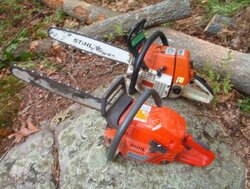- Dec 19, 2006
- 55
A friend of mine who runs a tree service dropped off a load of logs for me and I have been struggling to figure out a way to process them. The four maple logs are from big maple tree that died in town. THe logs are each about 2.5 - 3' in diameter and my Echo chainsaw with an 18" bar can't get too far through them. I thought about just chunking them up with cuts across and through the grain. This would leave me with some odd shaped pieces of wood that wouldn't stack very well. It is also difficult to manipulate the wood as the logs are too large to move without some form of power equipment beyond my iron bars and peaveys. Any ideas as to how to cut this up and process it with with my limited equipment?
Thanks!
Garet
Thanks!
Garet


